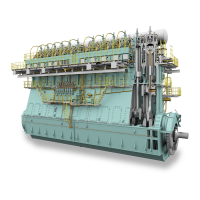Maintenance
1715−1/A2
Winterthur Gas & Diesel Ltd.
1/ 2
Oil Pressure Checks
1. General
Two hydraulic engine stays (1, Fig. 1) are installed on the exhaust side and two on the
fuel side of the engine.
The vibration dampening is done inside the accumulator body by a gas (nitrogen)
filled bladder surrounded with oil. The normal oil and gas pressure in service is:
80bar.
You must do regular checks of the two opposite engine stays at the pressure gauges
(3). Compare their values. The values must be the same if the vessel is level.
The faults that can cause a pressure decrease in a hydraulic cylinder are as follows:
D Defective O-rings
D Valves that have leaks
D Defective pipe connections
D Gas lost in the bladder accumulator.
1) Do a check of the distance (X) to make sure that the engine is not tilted. The
distance (X) must be zero before you do a check of the pressure gauges (7).
2) Do a check of the oil pressure values at the gauges (3). If the values of two
opposite engines stays added together are less then 120 bar, do as follows:
a) Refer to the documentation of the manufacturer, then do step b) to step e).
b) Decrease the oil pressure completely.
c) Refill the gas (Nitrogen) to a pressure of 40 bar.
d) Check if pressure stays constant − if not, there is a leak in the gas system.
e) Refill the oil to a pressure of 80 bar.
f) Check if pressure stays constant − if not, change piston sealing.
g) Make sure that the values on the pressure gauges are the same as on the
opposite engine stay.
Hydraulic Engine Stays
2015

